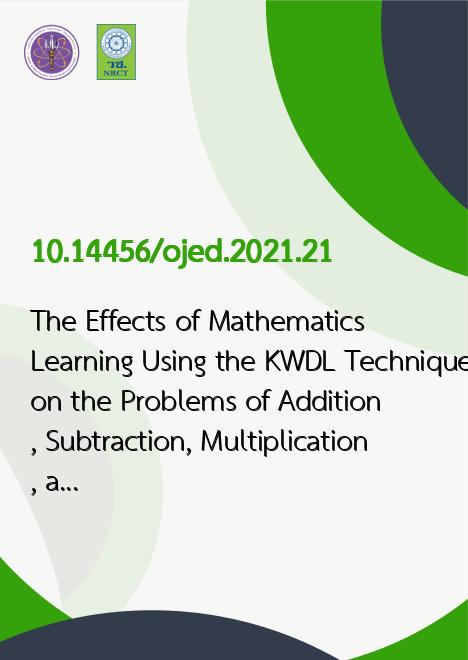
|
The Effects of Mathematics Learning Using the KWDL Technique on the Problems of Addition, Subtraction, Multiplication, and Mixed Division of Fractions and Mixed Numbers on the Learning Achievement of Prathom Sueksa Six Students |
|---|---|
| รหัสดีโอไอ | |
| Creator | Kunnakit Sudpan |
| Title | The Effects of Mathematics Learning Using the KWDL Technique on the Problems of Addition, Subtraction, Multiplication, and Mixed Division of Fractions and Mixed Numbers on the Learning Achievement of Prathom Sueksa Six Students |
| Contributor | Woranuch Yamsang, Nopporn Yamsang |
| Publisher | Centre for Education Innovation, Print and Online Media |
| Publication Year | 2564 |
| Journal Title | An Online Journal of Education |
| Journal Vol. | 16 |
| Journal No. | 2 |
| Page no. | OJED1602005 (15 pages) |
| Keyword | Learning using the KWDL technique, mathematics lesson plans, learning achievement, satisfaction |
| URL Website | https://so01.tci-thaijo.org/index.php/OJED |
| Website title | An Online Journal of Education |
| ISSN | ISSN 1905-4491 (Online) |
| Abstract | In this research, the researcher has the following objectives: to develop and determine (1) the efficiency of mathematics lesson plans using the KWDL technique with the criterion efficiency of 80/80; to compare (2) the mathematics learning achievement of the students under study prior to and after the study with the KWDL technique; and to examine (3) student satisfaction with mathematics learning using the KWDL technique. The sample population consisted of one classroom of thirty-three Prathom Sueksa Six students using the technique of cluster random sampling. The research instruments consisted of the following: (1) mathematics lesson plans using the KWDL technique; (2) a mathematics learning achievement test; and (3) a questionnaire eliciting student satisfaction with mathematics learning using the KWDL technique. Findings are as follows: 1. The mathematics lesson plans using the KWDL technique exhibited an efficiency of 93.90/81.18. 2. The students under study exhibited learning achievement after the study at a higher level than prior to the study at the statistically significant level of .05. 3. The student satisfaction with mathematics learning was at a high level at 71.33 percent of the number of all students responding to the questionnaire |